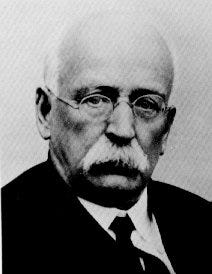Sir Ebenezer Howard
If you live on Howard Avenue, you may know your street is named for Ebenezer Howard, founder of the English Garden City movement and Radburn’s ideological godfather.
If you live on Owen, your avenue is named for Robert, the 19th century Welsh industrialist who founded the utopian socialist community of New Harmony, Indiana.
If you live on Burnham Place, your cul-de-sac honors Daniel, the Chicago architect and city planner who famously said, “Make no little plans.’’
But how did the many other avenues, streets and places in Radburn get their names?
Our best evidence comes from Charles Ascher, staff lawyer for the City Housing Corp., which developed Radburn in the late 1920s. In an interview recorded in 1970 and stored ever since at The Grange, Ascher said the street names were selected by himself and Louis Brownlow, Radburn's first project manager.
They did so, Ascher recalled, “one weekend at my place in Sunnyside Gardens (in Queens). … We cooked up the idea of having all the streets on a superblock begin with the same letter, so at least a man coming from outside could be guided. Then, we got names with historical meanings’’ – or, failing that, English ones.
According to the prevailing wisdom, he said, “People like to buy houses on streets that have nice Anglo-Saxon-sounding names.'' (This was gospel in the New York real estate world of CHC founder Alexander Bing. For example, Kew Gardens, the Queens garden suburb, was named for the famous botanical gardens in London.)
He and Brownlow had one other rule, Ascher added: “We decided not to commemorate any living people.’’
Besides the byways mentioned above, here are some other streets and the people or places for which or whom they probably were named.
Ruskin Place: John Ruskin, the 19th century British critic and philosopher whose ideas influenced the founders of the Garden City movement, and thus Radburn’s planners, Clarence Stein and Henry Wright.
Ballard Place: Edward L. Ballard, a New York insurance executive and associate of John D. Rockefeller Jr., the CHC’s largest single investor. Despite Ascher’s rule against naming streets for the living, Ballard was still breathing when the cul-de-sac’s houses were built circa 1932. But by then Ascher and Brownlow had left the CHC, and the name may have been selected by someone else.
Ashburn Place: Charles E. Ashburner, a municipal management pioneer and Brownlow mentor whom Brownlow identified in his autobiography as the first city manager in America.
Rutgers Terrace: Henry Rutgers, the Revolutionary War military officer and philanthropist for whom New Jersy’s state university also is named.
Brearly Crescent: David Brearly, an American Founding Father and jurist from New Jersey.
Sunnyside Drive (no part of which is in Radburn today, but might have been named before City Housing went broke in 1934 and sold much of its land): The CHC’s Radburn-forerunner development in Queens, Sunnyside Gardens.
Audubon Place: John James Audubon, the naturalist and ornithologist.
Landmark Lane (in The Crossings): Landmark Properties, the original developer of the site once known as Daly Field – itself named for Radburn’s longtime maintenance chief, Charles Daly.
But most of Radburn’s streets, such as Bristol, Bedford, Reading, etc., seem to have been chosen because they’re the names of cities or towns in England -- and thus, to our Yankee ears, sound classy.




Very interesting. Not surprising that they went Anglo on many of the names. By contrast, I live in Fair Lawn on Angelo Terrace, named after the Italian developer of much of the housing stock near the Glen Rick border. His son-in-law, builder Lew Kershner, is the inspiration for Kershner Place that intersects with Angelo Terrace.